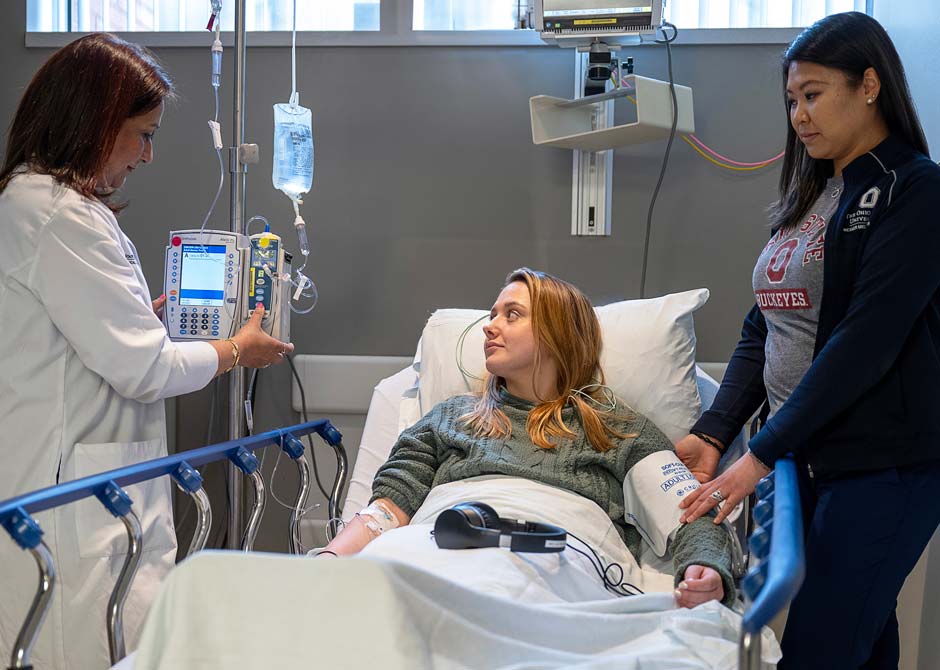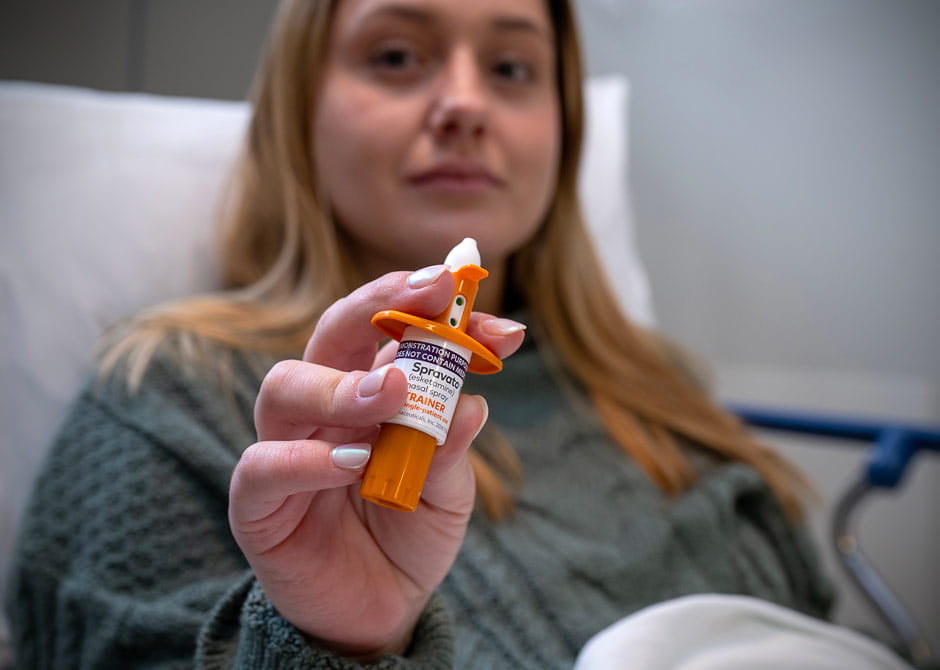 When you’ve been trying to find relief from difficult-to-treat depression or another serious mental health condition but haven’t seen improvement in your symptoms, it can be discouraging.
When you’ve been trying to find relief from difficult-to-treat depression or another serious mental health condition but haven’t seen improvement in your symptoms, it can be discouraging.
Fortunately, the mental and behavioral health experts at The Ohio State University Wexner Medical Center in Columbus, Ohio, have other forms of treatment to offer when traditional methods of medications and psychotherapy haven’t helped. Ketamine therapy can be a rapid-acting treatment for some, making it a breakthrough for managing these diseases.
At the Ohio State Wexner Medical Center, we’ve been at the forefront of studying the safety and efficacy of ketamine therapy for several years. We know and follow best practices for when it’s appropriate to use, who might benefit from it and how to safely administer it. We mainly offer intranasal esketamine, which is approved by the U.S. Food and Drug Administration (FDA), in our clinic, but do have other forms of the therapy available.
What is ketamine therapy?
Ketamine therapy uses low doses of ketamine, a dissociative anesthetic, to treat depression and suicidal thoughts and actions in adults with major depressive disorder. Usually, your condition is resistant to more traditional therapies, such as antidepressants and psychotherapy (talk therapy).
Ketamine has been used for decades in high doses as an anesthetic in the operating room, but more recently research has shown it can help some people with severe mood disorders. It can distort the perception of sight and sound and creates sensations of pain control, forgetfulness and euphoria, which reshapes the brain and can cause a shift out of depression.
This type of therapy is incredibly robust, with people seeing an improvement in their symptoms in the days following administration instead of waiting several weeks for antidepressants to work. It’s important to remember that not all the types of ketamine treatment are approved by the FDA, and the therapy should be administered under the supervision of a mental health professional.
What’s the difference between intranasal esketamine and other types of ketamine therapy?
Intranasal esketamine is a derivative of ketamine, called Spravato. It’s a nasal spray that requires a prescription and is administered in a doctor’s office. While it provides many of the same effects as other ketamine therapies, it’s the only type that is approved by the FDA. This is the main form of ketamine therapy we provide at the Ohio State Wexner Medical Center.
Sometimes a low dose of ketamine is administered intravenously for 40 minutes in sessions that happen twice weekly for a month. A low dose of ketamine can also be injected into the muscle, but this type of administration is less common.
Why is ketamine therapy used?
Ketamine therapy is used to treat certain mental health conditions. It’s important to remember that ketamine is not the first option for treatment used for these disorders, and typically, more traditional and longstanding treatments have been tried with no symptom relief before ketamine is recommended along with a prescribed antidepressant.
While we’re still researching all the possible conditions that can be improved with ketamine therapies, Ohio State uses it to treat these disorders:
- Treatment-resistant depression
- Depressive symptoms in adults with major depressive disorder (MDD) with suicidal thoughts or actions
 Who is eligible for ketamine therapy?
Who is eligible for ketamine therapy?
If other treatments have been unsuccessful in relieving your depression or other mental health condition, you might be eligible to try a form of ketamine therapy. There are various conditions or circumstances, however, that could disqualify you from receiving ketamine, so it’s important to talk to your doctor about whether the benefits of ketamine outweigh the risks.
You might not be eligible for ketamine if:
- You have a history of schizophrenia or psychosis
- You have a history of substance use disorder
- You’re pregnant or breastfeeding
- You’re under 18 years
- You’re an older adult with dementia symptoms
- You have a history of cardiovascular disease or severe liver disease
How does ketamine therapy work?
Ketamine is typically administered during one or more sessions in a clinical setting. It works by blocking a receptor in the brain that’s responsible for mood regulation, cognition and pain perception. Typically, ketamine is combined with other treatments, such as antidepressants or psychotherapy.
What to expect with ketamine therapy?
The process for ketamine therapy can vary depending on how it’s administered.
Before the procedure
Your health care providers will do a physical and mental examination to determine if you’re healthy enough to receive ketamine therapy and whether it’s the right course of treatment for you. Remember, ketamine therapy isn’t the first type of treatment we’ll try.
During the procedure
No matter how ketamine is administered, you’ll receive it in a hospital setting at the Ohio State Wexner Medical Center to ensure your safety.
If you’re receiving infusions, you’ll have an intravenous line inserted that will deliver the medication over a short period of time. We’ll monitor you and any possible side effects for a period after the treatment.
Usually, these infusions are given over multiple sessions, tapering in frequency.
With the FDA-approved intranasal esketamine (Spravato), a spray is administered into a nostril in a medical office. You’ll be monitored afterward to ensure any side effects are managed.
Results of the procedure
You’ll feel the effects of the medication while it’s being administered and after completing the treatments. Sensations may include elation, distorted feelings about your body or even a feeling of weightlessness.
Following the session, some symptoms of depression can improve within a week but sometimes it takes repeated treatments to feel better.
Risks associated with ketamine therapy
One of the biggest questions surrounding ketamine therapy is whether it’s safe. Just like with any medical intervention, there is always some risk; however, at the Ohio State Wexner Medical Center, we’ve studied the safety of ketamine therapy for years and can offer it in the most secure environment possible.
Possible side effects of ketamine include:
- Dizziness
- Fatigue
- Headache
- Blurry vision or sensitivity to light
- Elevated heart rate or blood pressure
- Mood changes
For most people, most of these side effects resolve quickly following the procedure. Other longer-term side effects might include bladder damage, urinary problems or liver toxicity. Having your ketamine therapy closely monitored by a health care provider in a medical setting will help you manage immediate side effects while mitigating more serious ones.
Does ketamine therapy cause addiction?
Since ketamine is a controlled substance, people can develop a tolerance to it, meaning it takes more of the drug to cause the same effect or you become dependent on it. This is another important reason why your ketamine therapy should be managed by a health care professional, who specializes in the therapy, to reduce your risk of addiction.
Why come to Ohio State for ketamine therapy
Administering ketamine therapy requires knowledgeable providers with an expertise in managing difficult-to-treat mental health disorders and a growing emphasis on novel interventional psychiatry methods. Our mental and behavioral health program at the Ohio State Wexner Medical has both and offers a level of care not available everywhere else.
Our differentiators include:
- Capacity – We recently increased our capability to provide ketamine therapy five-fold. We now have five chairs at our award-winning Harding Hospital to administer ketamine or intranasal esketamine, allowing us to offer this therapy to anyone who might need it.
- Research – As an academic medical center in a mental behavioral health program that has an emphasis on research, we’ve been at the forefront of conducting clinical trials surrounding the efficacy and safety of using ketamine to treat various conditions. You’ll have access to the latest advancements here.
- Expanding offerings – We hope to offer other psychedelic therapies in the future as we work to study best practices and benefits of this type of treatment.
